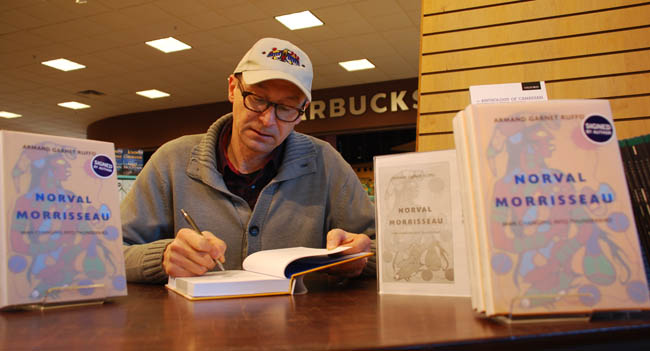Norval Morrisseau biographer paints pages with words

By Laura E. Young
SUDBURY – Armand Garnet Ruffo, author of a biography on Norval Morrisseau, paused, almost as if he was taking a deep breath, when he was first approached with writing on the renowned Ojibway artist, also known as Copper Thunderbird (1932-2007).
“Even though I was hesitant, the more I learned about him through writing those initial articles the more interested I became. It stayed with me. For me, projects find me. I wait. I keep an open mind,” Ruffo says.
Ruffo is also Ojibway and a professor in the English Department at Queen’s University in Kingston. Ruffo has also written four books of poetry and edited anthologies of Aboriginal literature. He was recently in Sudbury to sign copies of Norval Morrisseau Man Changing into Thunderbird, at Chapters and to speak on Indigenous writing at Laurentian University.
It’s a work of creative non-fiction nearly 10 years in the making.
The roots of the Morrisseau biography first begin to shoot in 2005. A National Gallery of Canada curator, Greg Hill, asked Ruffo to write for a catalogue celebrating the work of Morrisseau at the Gallery.
In 2006, Morrisseau would become the first Indigenous painter to have a solo show – Norval Morrisseau, Shaman Artist – at the National Gallery.
By 2010, Ruffo was wrapping up work on the film Windigo which tells of the intergenerational impact of the impact of the residential school system. He was “back into the mood” of writing on Morrisseau, and the project grew until it was a book.
For Ruffo, the research and writing also were a study in his own Ojibway heritage. Ruffo has family ties to Chapleau and Sagamok First Nations.
“The more I looked at his art the more interested I became in trying to decode it and understand it. And the more I learned about Ojibway culture at the same time. It was reciprocal thing going on.”
Morrisseau’s early work and use of monochrome, Earth tones intrigue Ruffo.
“When he started painting he was working on birch bark. He was really sticking to his (initial) sources, to pictographs and the Ojibway birch bark scrolls.”
Man Changing into Thunderbird is a biography, but Ruffo employs the many tools of a novelist to weave the threads of Morrisseau’s story. Telling the story in the present tense, Ruffo works through the swings that marked the complex life of the charismatic Ojibway painter.
Morrisseau spent plenty of time down and out in Canada: in jails in Northern Ontario or on the streets of Vancouver. He would emerge to add to his body of work and mingle with the wealth of the high art world.
Ruffo relates in fascinating detail an account of Morrisseau and Gabor Vadas finding each other on the streets of Vancouver. Vadas becomes his guardian and “apprentice-son.” Morrisseau emerges to create more powerful works, holing up for several weeks at Jasper in the Canadian Rockies.
From so many “interesting stories like that,” Ruffo would like readers to learn of the talent that was Morrisseau, an artist who eventually amassed a tremendous body of work that includes over 3,000 paintings.
“He not only assimilated new ideas into it, New Age ideas, but he really grounded it into indigenous, specifically Ojibway, culture.
“He made it new. He shows the relevance of this amazing culture. He showed that there is so much there that has been overlooked and how artists can use this, whether you’re a writer, playwright, filmmaker, or a visual artist. It’s very rich.”
Norval Morrisseau Man Changing into Thunderbird is available for $32.95 at Chapters in Sudbury and from publisher Douglas & McIntyre at www.douglas-mcintyre.com


